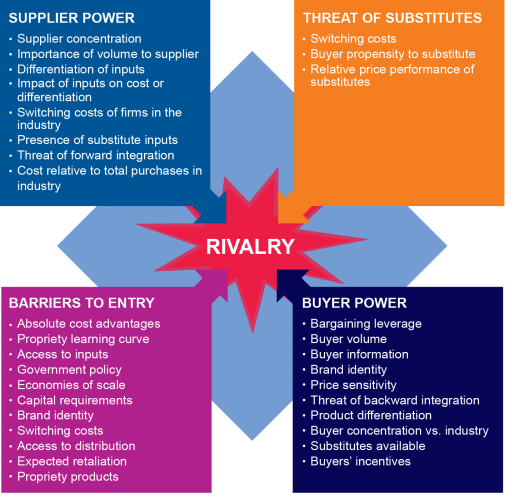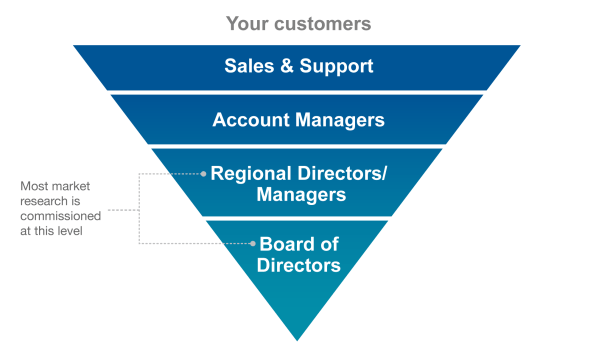This white paper explores the opportunity to gain unique and valuable market insights by tapping into what is often a neglected source for marketers – employees.
You Wouldn’t Base Your Company Strategy on the External View Alone
The reason why some companies outperform others is a regularly debated topic by influential strategists across the globe. Michael Porter, a famous contributor to organizational strategy, developed the well-known five forces of competition model.
In the 1980’s when the model was developed, Porter argued that an organization’s competitive advantage must emerge from a refined understanding of the rules of competition that determine market attractiveness.
The rules of competition that determine market attractiveness include:
Porter’s Five Forces

According to this model, the most important factor when determining an organizations profitability is ultimately how much value a firm is able to create for their customers and how much of this value will be captured by rivals.
The Five Forces model is a useful framework for assessing the operating environment of markets, but it is heavily weighted to external factors. Internal forces should also be considered.
Internal factors can be considered as ‘building blocks’ or resources for success. For example, a building block could be the unique culture of an organization which is dedicated to customer service. Another building block could be proprietary software which allows a company to process orders quicker than competitors. For some companies the building block could be their channel to market which gives a competitive advantage. Such internal building blocks are an important force for any company because they may not be immediately apparent to outsiders. Internal resources (ie building blocks) can be difficult to copy.
Your Employees Are a Unique Competitive Advantage
What constitutes a resource or core organizational competency is a topic academics continue to discuss. Employees are a widely recognized resource (an internal one), which can leverage competitive advantage within the marketplace.
As a result employee satisfaction and thus employee engagement has become increasingly important in recent years. Businesses across the globe are harnessing the power of their employees and the fundamental role they have on business success.
The rationale behind the importance of employees is simple. Even in business-to-business markets, no matter which industry sector you are operating in, fundamentally people do business with people.
One of the more commonly cited ways in which to keep employees engaged in their role is empowerment, alongside key areas such as respect, autonomy, belonging and personal growth.
There are numerous ways to empower employees and ensure that their voice is heard through the ranks of an organization. Coupled with this there are also clear business advantages of seeking the opinions of employees.
Knowledge Societies Are Growing
The importance of the employee has come about due to a shift in the type of organisations within the modern world. In the late 1990’s companies, politicians and the public in general became aware of the growing power of IT and the power of the Internet. Western countries are now viewed as new economies with knowledge being central to national prosperity.
The move away from traditional industry and manufacturing economy has also been seen within market research. There is a continued increase in demand for insights and knowledge around markets, customers and products. However, the increase of knowledge can make things more difficult – it can be more difficult to see the wood for the trees when there is too much of it.
So Where’s The Link Between Employees and Market Research?
Broadly speaking, organizations typically conduct market research in the following areas to help address or solve a business issue:
- Market entry / assessment
- Customer satisfaction
- Branding and the positioning of their brands
- New product development / concept testing
For each of these types of research, projects are often steered by a small number of stakeholders – typically from within the marketing function and typically not customer facing.
In all large organisations there is some form of hierarchy. Those with board level positions are unlikely to be interacting with customers on as frequent a basis as those in operational roles.
The following diagram clearly emphasizes a hierarchy found in most organisations in some form. Those who are in customer services roles within call centers, technical support or indeed account managers to some extent are unlikely to be feeding directly into the strategy of a large organization.

The ultimate advantage that employees hold is their regular interaction with customers and the marketplace. Those in sales based roles spend their days travelling the country speaking to customers, understanding their problems, and trying to sell their company’s products, services and solutions.
Employees understand barriers to adoption, the competition and organizational positioning amongst current, prospect and indeed lost customers.
It is likely that employees have views about how things could be done better, how processes could be more efficient or how the company could be easier to do business with. It is also likely that they will have specific knowledge on the market – the activities of the competitors, the size of the opportunity, the trends etc. This is good market intelligence that is sitting underneath the nose of every company and so often ignored. It is easily and inexpensively collected. Indeed, it should be one of the first ports of call for any company seeking insights into its marketplace.
There are three important ways in which adding the employee view will reap benefits.
-
Customer Research
Good service to customers begins from within. There are a number of useful ways in which the employees’ voice can be used to complement customer research.
In customer satisfaction studies it is useful to know what employees think are the company’s strengths and weaknesses. It is a useful benchmark to compare with customers’ views.
The internal view is also valid in segmentation studies. Account Managers know their customers well and they know how to recognise differences in needs. Using employees in an upfront workshop to brainstorm ideas on how customers could be segmented is a great way to build engagement from the start. Alongside enabling the researchers to build an effective questionnaire to test the different segmentation hypothesises.
-
Market Assessment
Identifying opportunities within existing and new markets is often complex, blending insights from a number of sources.
Employees have considerable market insights which should not be neglected. It is true that it could be subjective but that doesn’t mean to say that it is wrong. Very often it is simply “all over the place”, held in people’s heads or as snippets here and there. Market researchers can bring structure and order to these insights and create something meaningful out of random pieces of intelligence.
Employees’ opinions could be sought on topics such as competitors, knowledge about countries and any unserved areas of the market. Employees’ opinions here can be subjective and this must be accounted for. However in market assessment studies we are often searching for a unique opportunity and employees may be able to point us in the correct direction.
-
Branding
Brand is a topic close to the hearts of many different stakeholders in an organization. A key subject explored in most brand studies is the meaning of the brand – a search for what the brand stands for and the values that are associated with the brand.
Employees are a key stakeholder in the company they work for and therefore the brand and what it means to them. It is just as important to know employees’ views on a brand as it is to know customers’ views, for if there is a gap, it should be closed.
By using employees to build a brand, unique stories can be uncovered about the brand promise. By engaging employees in the branding process it is likely they will have strong associations with the brand going forward.
Additionally the brand associations and values of employees can be tracked over time alongside market brand health tracking research.
There are also a number of broader benefits involving employees in research projects. Many organisations face challenges with organizational change and employees may be resistant to this. Engaging employees in the research makes them feel engaged and empowered and as such more likely to embrace the change.
Finally, employees are “low hanging fruit”. They are readily and freely available to take part in internal surveys which makes them a very cost-effective way of gathering data.
How to Gather the Employee Perspective
Gathering intelligence from employees can take place in three ways:
-
Through internal workshops (qualitative research)
These are best held at the start and the end of a project. Workshops and consultations that take place when a study begins gets buy-in and will ensure that the final delivery of the results will be more readily accepted. The study is no longer “somebodies” it is “everybody’s”. Workshops at the front end are also very useful briefing sessions for the researchers who will be eager to know what knowledge gaps need filling.
The workshop at the start of a customer satisfaction survey provides an opportunity to map the customer journey and all of the customer touchpoints. Thinking through the customer journey and the different touch points can be cathartic for employees who may have built up a narrow perspective of how customers see the company from the outside.
Depending on the project, qualitative research may be beneficial to get under the skin of any issues and to gather a real understanding. This can be achieved through focus groups or face to face depth interviews. Although these methods are more time consuming they deliver rich and valuable insights.
-
Through primary research (quantitative research)
Surveys targeted at employees can easily be developed and delivered to employees e-mail addresses. Surveys of this kind are most effective when the majority of questions are rating questions (closed) thus gathering quantitative data. A structured survey aimed at employees can be quick and inexpensive to execute. Such surveys regularly take place on employee satisfaction though they could just as easily collect employee’s views on customer and market opportunities.
-
Through existing resources
Sales data collected over time provides rich material for analysis. Market researchers who are used to slicing and dicing information can learn a huge amount from data analytics. Historical sales data can show buyer behaviour, segmentation, and customer trends. Elsewhere within an organisation there may be other useful sources of data filed away. Market research reports may have been acquired, stored and forgotten. Earlier studies of competitors may still be relevant. Price changes over time may provide some indication of the effect on demand and therefore the price elasticity of products.
Closing Thoughts
This paper outlines the importance of leveraging the knowledge and views of employees to both engage the workforce and to create a unique organizational strategy. These insights can be gathered in a number of ways from workshops, e-surveys, depth interviews and data analytics. Taking the internal view is a sensible place to start any survey on the grounds that there is a huge amount of intelligence lying dormant within companies which may obviate the need to carry out an expensive external survey.
Readers of this white paper also viewed:
Market Sizing: Is There A Market Size Formula? Market Segmentation in B2B Markets Entering Chinese Business-to-Business Markets: The Challenges & Opportunities


